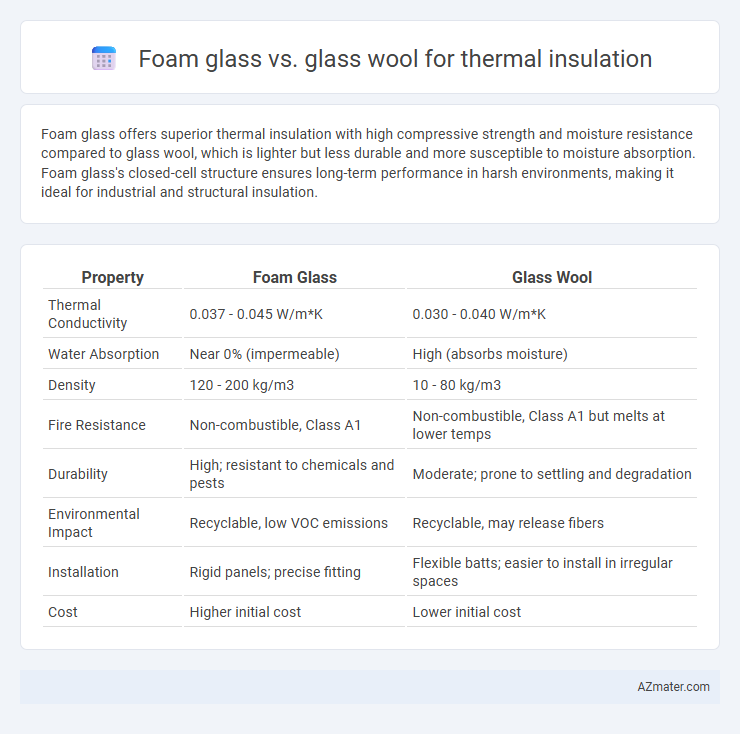Foam glass offers superior thermal insulation with high compressive strength and moisture resistance compared to glass wool, which is lighter but less durable and more susceptible to moisture absorption. Foam glass's closed-cell structure ensures long-term performance in harsh environments, making it ideal for industrial and structural insulation.
Table of Comparison
| Property | Foam Glass | Glass Wool |
|---|---|---|
| Thermal Conductivity | 0.037 - 0.045 W/m*K | 0.030 - 0.040 W/m*K |
| Water Absorption | Near 0% (impermeable) | High (absorbs moisture) |
| Density | 120 - 200 kg/m3 | 10 - 80 kg/m3 |
| Fire Resistance | Non-combustible, Class A1 | Non-combustible, Class A1 but melts at lower temps |
| Durability | High; resistant to chemicals and pests | Moderate; prone to settling and degradation |
| Environmental Impact | Recyclable, low VOC emissions | Recyclable, may release fibers |
| Installation | Rigid panels; precise fitting | Flexible batts; easier to install in irregular spaces |
| Cost | Higher initial cost | Lower initial cost |
Introduction to Thermal Insulation Materials
Foam glass and glass wool are prominent thermal insulation materials widely used in construction and industrial applications. Foam glass offers high compressive strength, moisture resistance, and excellent thermal performance with a closed-cell structure, making it suitable for harsh environments. Glass wool, composed of fine glass fibers, provides effective thermal resistance, sound absorption, and flexibility, commonly used in residential and commercial insulation projects.
Understanding Foam Glass: Composition and Properties
Foam glass is a thermal insulation material composed primarily of crushed recycled glass, mixed with a foaming agent that creates a cellular, closed-cell structure. Its chemical inertness, high compressive strength, low water absorption, and excellent thermal resistance make it ideal for applications requiring durability and moisture resistance. Unlike glass wool, foam glass offers superior compressive strength and dimensional stability, making it suitable for insulating foundations, roofs, and areas exposed to heavy loads and water.
Glass Wool: Structure and Key Features
Glass wool consists of fine fibers spun from molten glass, creating a lightweight, porous material with excellent thermal insulation properties. Its key features include high thermal resistance (R-value), sound absorption capabilities, moisture resistance, and flexibility for easy installation in various building applications. This structure allows glass wool to effectively trap air, minimizing heat transfer and enhancing energy efficiency in residential and commercial insulation systems.
Thermal Performance: Foam Glass vs. Glass Wool
Foam glass offers superior thermal insulation with an R-value typically ranging between 4.5 and 5.0 per inch, providing excellent resistance to heat transfer and moisture absorption. Glass wool has an R-value generally around 3.0 to 3.7 per inch, making it less effective in extreme temperature variations and more susceptible to moisture-related performance degradation. The closed-cell structure of foam glass enhances its durability and thermal stability compared to the fibrous, porous nature of glass wool.
Moisture Resistance and Durability Comparison
Foam glass offers superior moisture resistance compared to glass wool due to its closed-cell structure that prevents water absorption and inhibits mold growth. Foam glass demonstrates higher durability, maintaining its insulating properties and structural integrity over time in harsh environments, whereas glass wool can degrade and lose effectiveness when exposed to moisture. These characteristics make foam glass a preferred choice for applications requiring long-term thermal insulation with minimal maintenance in moist conditions.
Fire Safety and Non-Combustibility Factors
Foam glass excels in fire safety due to its non-combustible composition and resistance to high temperatures above 1000degC, offering superior protection in fire-prone environments compared to glass wool, which contains organic binders that can ignite under extreme heat. Glass wool, while effective as a thermal insulator, may release toxic fumes when exposed to fire, posing additional safety risks. The inherent non-combustibility and chemical stability of foam glass make it a preferred choice for applications demanding strict fire safety compliance and enhanced durability.
Environmental Impact and Sustainability
Foam glass insulation offers superior environmental benefits due to its composition from recycled glass and long lifespan, reducing landfill waste and resource consumption. Glass wool, while also incorporating recycled materials, typically requires more energy-intensive manufacturing and may release irritants during installation, impacting indoor air quality. The durability and non-toxic nature of foam glass make it a more sustainable choice for thermal insulation in eco-conscious construction projects.
Cost Efficiency: Installation and Maintenance
Foam glass offers higher durability and moisture resistance, resulting in lower long-term maintenance costs compared to glass wool. Although foam glass has a higher upfront installation cost, its rigid structure reduces the need for frequent replacements and repairs, enhancing overall cost efficiency. Glass wool is typically cheaper initially but may incur additional expenses due to its susceptibility to moisture damage and compression over time.
Typical Applications in Construction and Industry
Foam glass excels in thermal insulation for industrial applications requiring high compressive strength and chemical resistance, such as pipe insulation, tank supports, and roofing systems. Glass wool is commonly used in construction for wall cavities, ceilings, and HVAC duct insulation due to its lightweight, flexibility, and excellent sound absorption properties. Both materials offer superior thermal performance, but foam glass is preferred for load-bearing and moisture-prone environments, while glass wool suits interior insulation needs.
Choosing the Right Insulation: Foam Glass or Glass Wool?
Foam glass offers superior compressive strength, moisture resistance, and durability, making it ideal for applications requiring long-term insulation in harsh environments. Glass wool excels in thermal performance, sound absorption, and cost-effectiveness, suitable for residential and commercial insulation where flexibility and ease of installation are priorities. Selecting between foam glass and glass wool depends on factors such as environment, load-bearing needs, moisture conditions, and budget constraints to ensure optimal thermal insulation performance.

Infographic: Foam glass vs Glass wool for Thermal insulation
 azmater.com
azmater.com